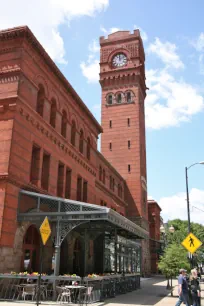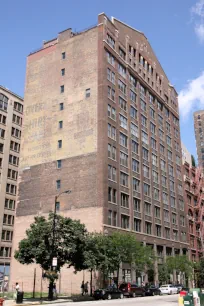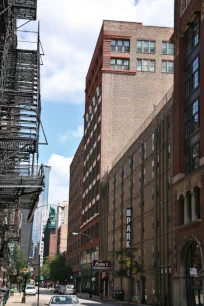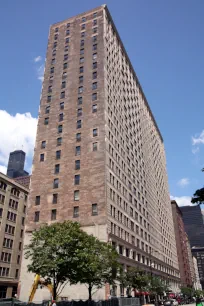Printers Row – or, officially Printing House Row Historic District, was once the heart of Chicago’s printing business. Those companies moved out long ago, but many of the massive buildings that housed offices and printing machinery have been preserved.


Printing Business Heyday
This area in Chicago’s South Loop started to develop in the late nineteenth century, after the construction of the Dearborn Street train station started to boost the commercial activity in the area, and in particular the printing industry.
Both printers and publishers were attracted by the proximity to the railroad terminal and the ample space that had become available as a result of the Great Fire of 1871. They erected purpose-built offices and print plants designed to support the heavy printing machinery.
During its heyday, the Chicago printing industry was one of the largest in the US, but in the 1960s printing businesses started to relocate to the suburbs and when the Dearborn Street Station closed in the early 1970s, the area started a rapid decline.
Reconversion
Concerned citizens – in particular architect Harry Weese – petitioned to protect the historic buildings, and in 1976 they succeeded in placing the Printers Row District on the National Register of Historic Places.
In 1996 Printers Row was designated a Chicago Landmark, further protecting the district’s historical value. Meanwhile, many of the buildings were converted into modern office lofts and condominiums, revitalizing the neighborhood.


Buildings
Some of the buildings in this district were designed by reputable Chicago architectural firms, such as the fourteen-story Pontiac Building at 542 South Dearborn Street. The Pontiac Building, constructed in 1891, is the oldest surviving building by Holabird and Roche. In 1986, it was reconverted into an office building by Booth/Hansen and Associates.
Several buildings in Printers Row have decorations that refer to the printing business, in particular the Franklin Building at 720 South Dearborn, which was built in 1912 to house printing businesses. The brick building, designed by George C. Nimmons, is decorated with colorful glazed tiles and terra-cotta ornamentation created by Oskar Carl Gross. A mural on the facade of the building above the entrance, entitled ‘The First Impression’, depicts early printers. The Franklin Building was converted into condominiums by Lisec and Biederman in 1987.
The facade of the Pope Building at 633 S. Plymouth Street is also decorated with terracotta ornaments. It was built in 1904 to house a printing company; in 1986 it was converted into apartments, also by Lisec and Biederman.
The largest building in the area was the Transportation Building at 600 S. Dearborn Street. This is one of the few buildings here that had no connection to the printing business: it housed offices for railroad companies. Built in 1911 by Fred V. Prather, the massive structure was converted into an apartment building by Harry Weese and Associates in 1983.
Many other historic buildings are worth a closer look such as the Moser Building at 621 S. Plymouth Street, The Old Franklin Building (1888) at 525 S. Dearborn Street, the Terminals Building at 537 S. Dearborn Street, The Mergenthaler Building at 531 S. Plymouth Street and the Morton Building at 538 S. Dearborn Street.

